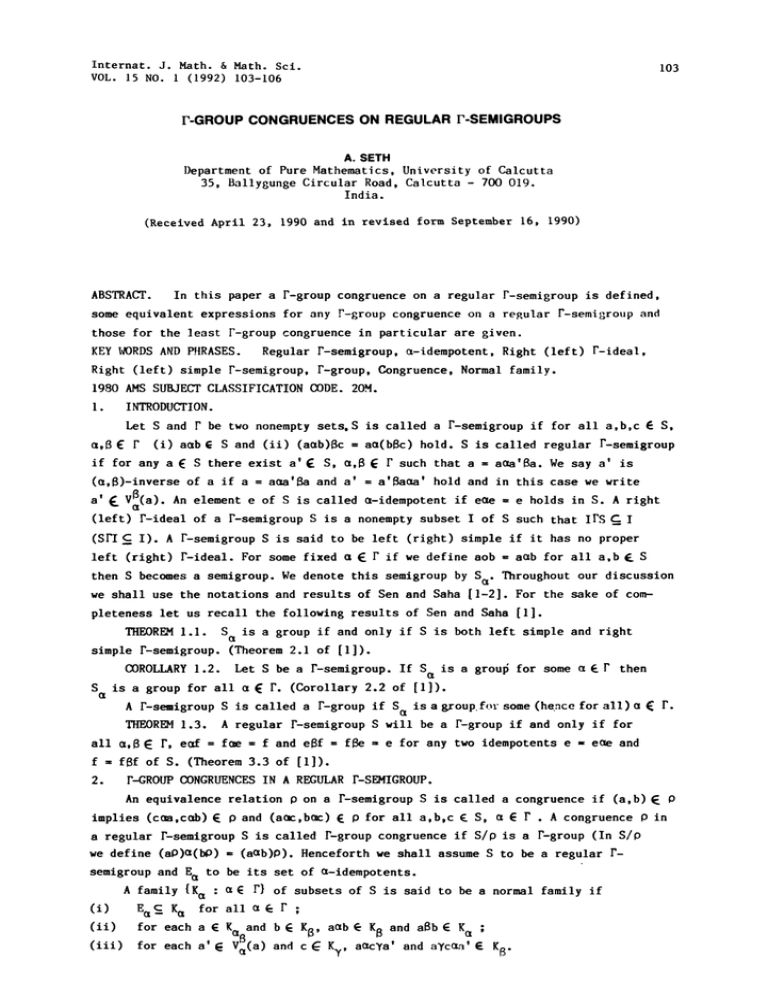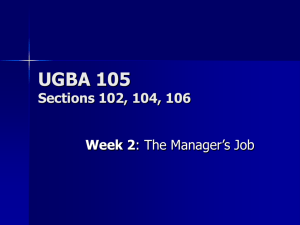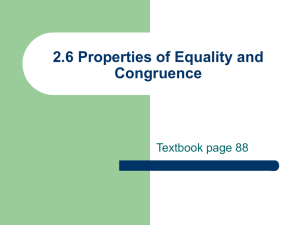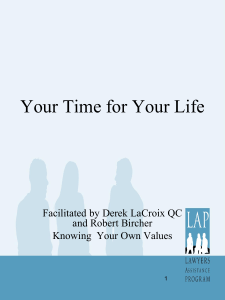Document 10442950
advertisement

Internat. J. Math. & Math. Sci.
VOL. 15 NO.
(1992) 103-106
103
I"-GROUP CONGRUENCES ON REGULAR F-SEMIGROUPS
A. SETH
Department of Pure Mathematics, University of Calcutta
35, Ballygunge Circular Road, Calcutta
India.
700 019.
(Received April 23, 1990 and in revised form September 16, 1990)
ABSTRACT.
In this paper a F-group congruence
on a regular F-semigroup is defined,
some equivalent expressions for any F-group congruence on a regular F-semigroup and
those for the least F-group congruence in particular are given.
KEY WORDS AND PHRASES.
Regular F-semigroup, a-idempotent, Right (left) F-ideal,
Right (left) simple F-semigroup, F-group, Congruence, Normal family.
1980 AMS SUBJECT CLASSIFICATION CODE. 20M.
INTRODUCTION.
1.
Let S and F be two nonempty sets, S is called a F-semigroup if for all a,b,c E S,
a,B
F (i) aab G S and (ii) (aab)Bc aa(bBc) hold. S is called regular F-semigroup
if for any a E S there exist a’ S, a,B
F such that a aoa’Ba. We say a’ is
_
(,B)-inverse of a if a
aoa’Ba and a’ a’Baoa’ hold and in this case we write
An element e of S is called =-idempotent if ee e holds in S. A right
(left) F-ideal of a F-semigroup S is a nonempty subset I of S such that I FS I
(SFI C_. I). A F-semigroup S is said to be left (right) simple if it has no proper
S
ab for all a,b
left (right) F-ideal. For some fixed a E F if we define aob
our
discussion
by
We
S
denote
a
this
becomes
Throughout
then
semigroup
semigroup.
we shall use the notations and results of Sen and Saha [1-2]. For the sake of completeness let us recall the following results of Sen and Saha [1].
is a group if and only if S is both left simple and right
THEOREM 1.1.
simple F-semigroup. (Theorem 2.1 of [1 ]).
is a grou for some
COROLLARY 1.2. Let S be a F-semigroup. If
E F then
S is a group for all a F. (Corollary 2.2 of [1]).
F.
is a group.for some (hence for all)a
A F-seigroup S is called a F-group if
THEOREM 1.3. A regular F-semigroup S will be a F-group if and only if for
all =,B F, ef
f and eBf
fe
fe e for any two idempotents e ee and
f
fBf of S. (Theorem 3.3 of [1]).
F-GROUP CONGRUENCES IN A REGULAR F-SEMIGROUP.
2.
An equivalence relation O on a F-semigroup S is called a congruence if (a,b) O
F A congruence O in
and (aac,bc) E D for all a,b,c
S,
implies (ccm,cb)
a regular F-semigroup S is called F-group congruence if S/D is a F-group (In S/O
we define (aO)(bO)
(ab)O). Henceforth we shall assume S to be a regular F-
a’
VB(a).
S.
S=
Sa
Sa
semigroup and Ea to be its set of a-idempotents.
A family {Ka a F} of subsets of S is said to be a normal family if
E
(i)
Ka for all a F
for each a
(ii)
Ka and b KB, aab K and aBb Ka
B
(iii) for each a’
and c Ky, aacYa’ and aycaa’ E K
B.
a_
VaB(a)
A. SETH
104
V:(eBf).
Thus
and
Now let e E Ea and f E
E r. Let x E
Then fexbe
r,
for all
r. We further note that in
consequently
for all D
r} is a normal family of S.
an orthodox r-semigroup S of Sen and Saha [2] {E a
let N be the collection of all normal families K. of S(iE A) where
1
r}. Then obviously
r}. Let Ua
a
K
and U
i
^. Thus
then a
Also if a Ua, b
A, b
for all
for all i
E
E
iAia
{Ki
ab
Ki8
US,
Ki
E U.
{U
Ki
for all i A
aBb, V(a) and
and
can show that if a
Ue
c
E.
U
KiB
and aBb
implying aab
then aecya’, ayca’ U
B.
Ua. Similarly we
Thus U is a normal
family of subsets of S and U is the least member in N if we define a partial order
for all
r. We also observe that when S is orthodox
in N by K
iff
a
KiaC_ Kj
Kj
i
{E
r}.
r-semigroup, U
a
r}
THEOREM 2.1 Let S be a regular r-semigroup. Then for each K
N,
is a r-group
oK {(a,b) SxS a=e fBb for some a,B r and e K=, f
congruence in S.
Then a=(a’a)
(aa’)Ba implies (a a) O
PROOF. Let a S and a’
{Ke
KS}
VBa)
K
Next let (a,b) OK. Then there exist e K, f K B for some ,B r such that
and b’E
ae
such that be((b’fBb)y(a’Sa)
fBb. Let a’
((beb’)(aaeya’))Sa. But b’fBb K e, a’Sa
and
and so (b’fgb)Y(a’Sa) K e
bgb’
aaeya’
and so (beb’)(aeya’)
Consequently, (b,a)
OK Now
r, e K, f K B, g Ky,
let (a,b) OK, (b,c)
OK Then there exist ,B,Y,5
h
such that ae
fBb and bg hSc. But a(eyg)
(ae)yg (fBb)Yg fB(bYg)
fg(hSc)
and fBh E
(fBh)c where e’fg
Thus (a,c) O and consequently
K
r, c s. Then ae fBb for
OK is an equivalence relation. Let (a,b) OK,
Let c’
some a,Br and some e
yE
x E
Ka, fe
V(a)
V(b)
Ky
K,
KS.
K5
K5
K
KS.
Vy6(c)
KB.
V61(bec),
V(aec).
(agc)(c’5((cY2x52a)ae)ec)Y1 (y51(bec)) (aecY2x)2fB(becYlY)51(bgc). But
cY2x2a EeC K e, so (cY2x2a)ae K e, c’((cY2x2a)ae)8c Ky. Again
y61(bgc) Ey C__ Ky and consequently (c’6((cY2x2a)ae)ec)Y1(Y61bec) Ky. By a
similar argument welcan show that (agcY2x)62fB(becY1Y) K6
Thus (aec,bc) 0K.
1
Now
Also it is immediate from the foregoing by duality that (cg,cgb) O
K Thus OK is a
congruence on S. Also as S is regular, S/p is a regular r-semigroup. Let e Ea,
K
EB. Then ear, fae K B, eBf, fBe Ka. Now (eaf)Bf (eaf)f shows that
(fae)Bf implies that (fae,f) OK. Thus (eOK)a (fOK)=fOK
and (fae)Bf
(eaf,f)
and (fOK)a(eOK)
eDK and (fPK)(eOK) eO K.
fO K, Similarly we can show (eK)B(fK)
So it follows from Theorem 1.3 that S/K is a r-group. Thus OK is a r-group congruence on S.
For any normal family K {K a a r} of s, the closure KW of K is the family
defined by KW
{(KW)y y r} where (KW)y {x S eax Ky for some a r and
e
We
call
K closed if K KW.
KQ}.
f
K
DK
For each K N,
Let (a,b) PK" Then fBa
THEOREM 2.2
PROOF.
{(a’b)
bee for some
a,B
r
and
VC(b)}.
orsome b’
Ka, f KBe
aYb’(. "o
SsS
for some b’ V(b). Consequently ayb’ (KW). Conversely,
K
and e e Ka. Therelet ab’
(KW) for some b’ Vy(b). Then eaayb’e K for some a r for
some a’
So (bg(a’eaa)yb’)a be(a’fa),
Ve(a)
f where f
fore eaa{b’
K.
Consequently (a,b)
K and
where
Then fB(ayb’)
baeyb’
bg(a’eea)yb’
a’fa
6
For any congruence 0 on
(ker O)
a
{x
S
eox
S, let
for some e
KS.
ker, 0
Ea}"
K"
{(ker
)a
a 6 r} where
-GROUP CONGRUENCES ON REGULAR
,
LEMWA "2.3. For any K E
PR()F. To prove ker o
K
F- For this let x (ker
OK)a
105
W.
ker O K
KW,
-SEMIGROUPS
we are to show that
F. Then
for some a
Ea,
(k.er
OK)a
eOKX
(k:’)r
for some e
for a]
la
that is
f
So gyx
1’bus
as ef E
gyx for some ;3,7 F, e
K, g
x
(KW)
Next let x
Then
Now
K
(KW)
for some
for some y
gyxE
F and g K
E ea(gyx)
e
(eg)yx where gyx K and eag E K Thus eoKx. Consequently
x
(er OK)
a. So (ker OK) a (KW) u for all a E F.
(KW) 6 for some b’
t K N and suppose ayb’
Vy(b). en eaayb’ K 6 for some
a E F and e E K
a’b(eYb’)6a K@and (a’eaaYb’6a)Oa’bb
a. Then for any a’
(a’ea)yb’6(aOa’)b
us a’b E ()8" Conversely, suppose a’b (KW) 0 for
F and f K and a0(fBa’b)a’
for some B
some a’
fB(a’b) E
B
K
(aOfBa’bOa’)(aYb’)
Therefore for some b
us ayb’ (KW) 6 for some (all) b’ V(b)iffa’b (KW)
erefore ayb’
for some (all) a’
Interchanging roles of a and b we see that ba’
for some (all) a’ V(a) iff b’6a
Moreover, the
(4) for some (all) b’
for
b
some
syetric property of 0 shows that ayb
(all)
(KW)
y(b) iff
K
ef
K.
K
Ky.
V(a),
V(a).
KO.
(a0fBa’)bb0(a’ba)Yb’
(KW).
V(a).
boa’
m.
K
The V6y(b),
V$(b).
(KW) for some (all)
b
LIA 2.4. For each
a’
N,
V(a).
aOKb
us
we have the following.
iff one of the following equivalent conditions
hold.
(i) ayb’E (KW) 6 for some (all)
for some (a11) b’e V6(b)
(ii) b’a E
(iii) a’bE (KW) for some (all) a’
for some (all) a’
(iv) ba’ E
Let N denote the collection of all closed families in N, then N N.
THEOREM 2.5. The mapping K
for some b’
{(a,b) SS aYb’
0K
is a one to one order preserving mapping of N onto the set of F-group congruences
(KW)y
V(a).
(KW)
V(b)}
K
on S.
PROOF. Let O be a F-group congruence on S. Let us denote ker O
Then K
{x S xOe when e Ea} Then E C Kaby K and (ker O) by
a
E Now (ab)o
(aO)(bo)
and f
Let a Ka, b E K then ape and bof where e
B.
B
(eo)a(fo) fo. Thus abof, where f E B. Thus ab K B. Similarly aBb
K Then cog where g E Then (cya’)O (aO)(co)y(a’O)
and c
Next let a’
(ao)a((gO)y(a’o)) (ao)(a’o) (aa’)O. Thus acya’Oaaa’ where aa’ EB. Hence
acya’ K Similarly ayca’ K B. Therefore K is a normal family of subsets of S.
B.
F}. Then
C_ (KW)y. To
for some
where e
{x S ex
Next
K a. Consequently
and
F
for
some
eax
Then
x
e
let
show
Thus
(ex)O gO where g
or(eo)(xO) gO or, xO go or, x
K.
Ea
K=.
V(a)
Ky
(KW)y
(KW)y Ky,
()y.
K
Ky
Ky
(KW)y Ky.
Ky.
Ey
Therefore K
KW and so K ker O
N. Thus if O is a F-group congruence, then
ker O
K N. We shall now prove that O
for
K O. If (a,b) O K then aYb’E
some b’
Thus aYb’ O h for some h
and aO
(aO)Y((b’Sb)o)=(hO)(bO)=bO.
Thus
O. Conversely, if (a,b)
O and b’
n’
byb’
a,b). K.
Therefore O O Thus from above and by lemma 2.3 for any
/
K
N,
a
oneK
OK-iS
to-one mapping from N onto the set of all F-group congruences on S. Also it is easy
V$(b).
OK
to see that
Let
K
ker
K
K5
E5
V$(b),tIenyb,’o
E0
O K is an order preserving mapping.
F-group congruence on S, by the proof of Theorem 2.5
N. Thus each F-group congruence is of the form O for some
/
I be a
K
OK,
KN
where
N.
106
A. SETH
Thus hy lemma 2.3 we have,
THEOREH 2.6. The least
F-group congruence o
.
on S is given by 0
For any F-group congruence O with K
K
EOREH 2.7.
in
N, on
0 and kero=
U
regular F-semigroup,
a
the following are equivalent.
(i)
(ii)
(iii)
aOKb.
K
axYb’ E
a’&xb K 0
for some
K
for some
bxga’
(iv)
for some
xK
K
xK
(
(E
(B
(B
F)
F)
F)
F)
V(b).
and some (all)
b’
and some (all)
a’ V(a).
and some (all)
a’
V(a)
(v) b’xaE K, for some x K
and some (all) b’V(b).
(vi) ae
=,B
for
some
F
and
fBb
some e
K, f
(vii) e
F and some e K, f
bBf for some
(viii)
for some ,B
F.
PROOF. (ii) => (iii) Suppose axyb’
for some x
and b’
Then for
a’(axyb’)b
any a’
(a’a)(x(b’b)) K 8 as a’a K@ and xyb’b
for a’
(iii) => (vi) Let a’xb
and x
Then ag(a’xub)
(aa’x)b which is (vi) as a’xb
and aga’x
(vi) => (viii) Let a=e
fBb for some ,B F and e
f E K
Then we have
,
KBBaKaO KBbK
V(a),
KS.
K.
K
V(a)
K8
K.
b.
KBBaK KBBbK
b. Then xBay
y,yl
K=.
If
a’ EV(), b’
ag(a’xBa=y)yb’
V(b),them’a’xBa
(a@a’)b(xBay)yb’
EK 8
K.
B.
XlBb=y
for some x,x
and (a’xBa)y
KB
KO
(a@a’)XlB(b=YlYb’) K
(aga’)b(XlBb=y l)Yb’
baYlfb’ K, XlB(b=YlYb’) K
K.
K@
K
fBfBbe implying
(viii) => (ii) Let K^BaK (l KBbK
fBaaee
Vy(b).
K
K.
and we have,
and a@a’
Thus (ii), (iii), (vi) and (viii) are equivalent.
Interchanging the roles of a and b we see that (iv), (v), (vii) and (viii) are
equivalent. Also (i) and (vi) are equivalent by Theorem 2.1. Thus all the conditions
as
(i)
(viii) are equivalent.
COROLLARY 2.8. Let o denote the least F-group
group S. Then the following are equivalent.
(i) aOb.
r) and
(ii) axb’
for some x
(iii) a’xb
for some x
F) and
(iv) buxea’@
for some x
F) and
F) and
for some x
(v) b’xa
(vi) aae
fBb for some =,B E F and e Ua
(vii) eaa bBf for some a,B F and e U
for some a,B
F.
(viii)
UoBbU_.mu
U
U
U
Uy
UBBaoUQ
U(
U(
U(
U(
congruence on a regular F-semi-
V(b).
some (all) b’
some
(all a’
V(a).
V(a).
some (al)
a’
some (all)
b’V(b)_
f
f
UBU
8.
ACKNOWEMENT. I express my earnest gratitude to Dr. M.K. Sen, Department of
Pure Mathematics, University of Calcutta, for his guidance and valuable
suggestions.
I also thank C.S.I.R. for financial assistance during the preparation
of this paper.
I am also grateful to the learned referee for his valuable
suggestions
fom the improve-
ment of this paper.
I.
2.
REFERENCES
SEN, M.K. and SAHA, N.K., On F-semigroup-I. Bull.Cal Math. Soc
180-186.
....
78 (1986)
SEN, M.K. and SAHA, N.K., Orthodox F-semigroup. Internat. J. Math. &
Math Sci
to appear.






